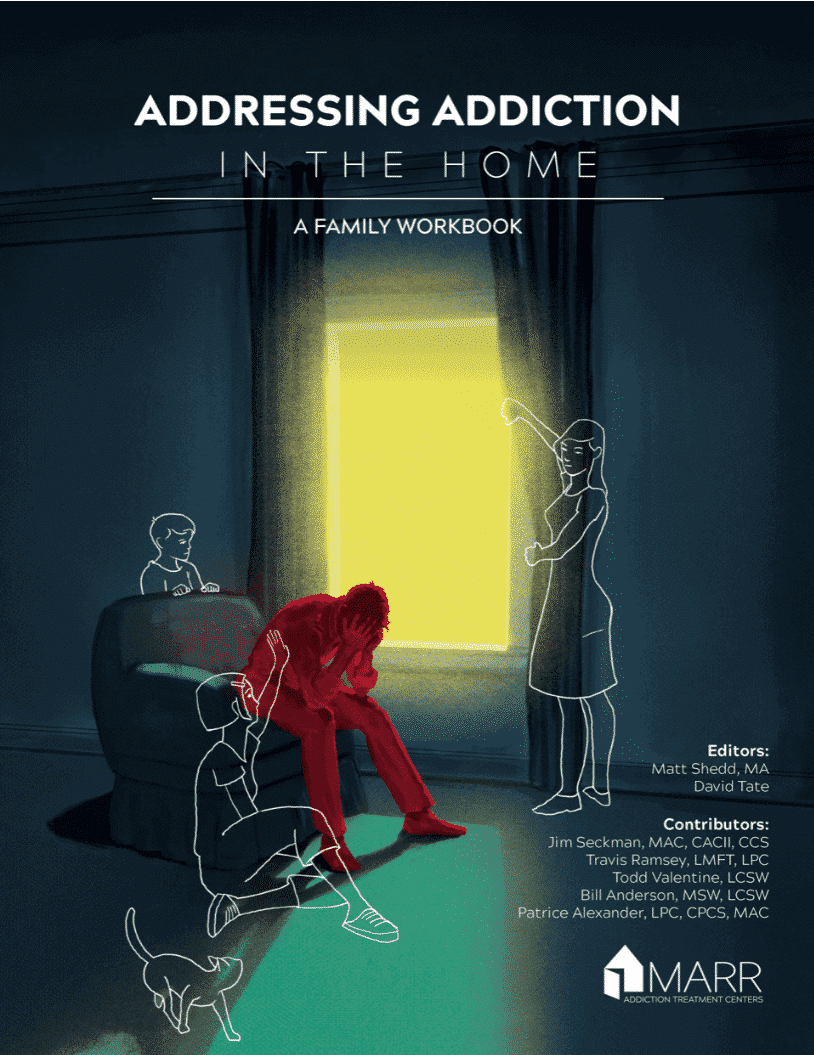
By Todd Valentine, LCSW
MARR Addiction Treatment Centers
This article is excerpted and adapted from a chapter “Enabling, Rescuing, Controlling” of Addressing Addiction in the Home: A Family Workbook. For the full text along with the worksheet exercises, please visit www.www.marrinc.org/workbook to purchase your copy.
Good Intentions, Bad Outcomes
Loving family members and friends don’t intend to support the progression of their loved one’s illness. But addiction is both subtle and powerful, and the family members’ best intentions to help their addicted loved one frequently get co-opted in service of the disease when the family members become codependent.
Many codependent behaviors fall into three broad categories of “enabling,” “rescuing,” or “controlling.” These actions often appear to be helpful and supportive, and if the loved one was not at the mercy of his or her addiction, the same actions might actually be loving and supportive. However, addiction radically changes family dynamics, taking good intentions and turning them into bad outcomes.
It’s important to look at the most foundational principle for loving someone with an addiction: Just as the addict or alcoholic is powerless over alcohol and drugs, family members are powerless over whether or not their loved one continues to use or drink.
Ultimately, the addicted person’s recovery from substance use is their responsibility, just as the family’s healing is their own responsibility.
There are two primary reasons family members enable their loved one in his or her addiction: they want to help, or they are afraid.
What is Enabling?
The term “enabling” is used in the context of problematic behavior (in this case, addiction) to signify dysfunctional approaches that are intended to help but, in fact, may perpetuate a problem (in this context, addiction). A common theme of enabling is that third parties take responsibility, blame, or make accommodations for a person’s harmful conduct (often with the best of intentions, or out of fear or insecurity, which inhibits action).
There are two primary reasons family members enable their loved one in his or her addiction.
- Family members want to help. As mentioned above, the disease is very good at turning our good intentions into bad outcomes. You may reach out to your loved one to help, but the disease turns your intentions against you and your loved one. In some cases, we are talking about behaviors that may work fine and even be helpful in healthy relationships.
- Family members are afraid. When fear grabs ahold of a family member, it is very difficult not to respond. It is normal to think: What if they don’t pay their phone bill, and I can’t reach them? What if they don’t pay their rent and end up homeless? What if they are in physical danger? What if they die or hurt somebody? The next thought is: I NEED to go do something.
It’s also important to remember that addicts are experts at catastrophic thinking and building up worst-case scenarios. By being around them, we are trained in that habit as well. It becomes difficult for us to distinguish what is true from what isn’t.
It might be that taking action is helpful, but, oftentimes, it is not. That is why family members need the support of a 12 Step Fellowship of their own, like Al-Anon or Nar-Anon. People in these communities will help you distinguish between when action is helpful or just another means of getting pulled into the whirlpool of dysfunction again.
Rescuing the addicted person from consequences may seem to work in the short term, but, ultimately, it sabotages the natural learning and human development process.
What is Rescuing?
Rescuing is a specific type of enabling that impedes the addict from learning that behaviors have consequences.
Some examples of rescuing loved ones are as follows::
- Preventing cars from being impounded
- Bailing them out of jail quickly without a treatment plan in place
- Paying off debts so their credit is not affected
- Paying a phone bill so their phone is not cut off
- Calling in sick for them
- Repairing their cars
- Paying tickets and other legal fees
Rescuing the addicted person from consequences may seem to work in the short term, but, ultimately, it sabotages the natural learning and humans development process. Natural consequences are some of the best teachers we have, and removing those distorts the addicted person’s sense of reality. We all have two primary ways of learning: intellectual learning and experiential learning. Intellectual learning, like reading a book, may be helpful in pointing us in the right direction and giving us an idea of what to do. But the real learning, most of the time, seems to come through experience. Learning through experience requires emotional risk that allows the lesson to take root more deeply.
If the addicted person does not experience the consequences of poor choices and the sense of fulfillment that comes with emotional independence, it puts that individual at a disadvantage when it come to really grab hold of a new life of independence and usefulness. If the family continues to rescue, the addict begins to rely on the family to do so more and more, knowing that inevitably the rescuer will be there to save the day.
A more compassionate way to respond to those you love might be to allow them to face the consequences of their actions, even when it will cause them pain. When relationships become centered around rescuing behaviors, it usually takes a lot of support for family members to disentangle themselves. Throughout this process of building healthy boundaries, the person who has been enabling the addicted loved one must learn to sit with the addicted person’s discomfort as well as their own.
Controlling behaviors might get short-term results, but the pressure exerted to get these results ultimately strain and in many cases break the relationship.
What is Controlling?
Controlling is another type of codependent behavior in which family members manipulate the addict in order to control their emotions. When the enabler tries to use emotions or threats to dictate what the addict must do, the enabler is trying to control the addict.
Here are some examples of how family members attempt to control the addict:
- Using anger to make the addict feel guilty
- Using guilt to try and stop the addict’s behavior,
- Using threats like “I’m leaving you” to change the addict’s behavior.
Using your emotions to attempt to control the behavior of the addict does not ultimately work to bring about long-term change. You might get short-term results, but the pressure exerted to get these results ultimately strains, and in many cases, breaks the relationship. Rather, it fuels the anger, resentment, guilt, and shame already present in the addict, as well as fueling the frustration, disappointment, and sorrow present in the family member.
If you’re beginning to recognize that you might be someone who tries to control other people there are two main things to be gained by stopping. The first is becoming an emotionally healthier person. The second is becoming someone who can have healthier relationships. There is a third possible benefit as well. Though there are no guarantees, the addict may trust the family member more than he or she would if the family member had continued trying to control him or her. If the family member keeps trying to control the at-risk individual, that individual may not be able to trust the individual at all.
Boundaries are loving and provide freedom to the loved one, whereas threats are abusive attempts to control the loved one.
When we are trying to set boundaries, it is important to ensure that we are not actually threatening the person we care about instead. Boundaries and threats may look similar, but they are profoundly different.
Boundaries are loving and provide freedom to the loved one, whereas threats are abusive attempts to control the loved one. And there is only one thing that separates a boundary from a threat: follow-through.
If a family member says, “If you come home drunk again, you are out of the house” but then fails to act once that happens again, then, it is a threat. If a family member says that and then follows through, then, it is a boundary.
People in active addiction are used to being threatened and have become adept at detecting when the other person will actually follow through or not. When family members attempt to manipulate with a threat, the addicted loved one often sees through the threat and is actually manipulating the family members right back. A lot of times, this whole process has become so automatic and unconscious, that neither side even realizes that they are doing this.
When setting boundaries you may feel you are being cold or uncompassionate toward your loved one, but in actuality refusing to continue to enable them is the most loving thing you can do for them.
Breaking the Cycle Requires Some Help
Enabling, rescuing, and controlling are relationship patterns that have been well established between you and your loved one over the course of years.
The addict’s invitations to enable and your impulse to rescue are difficult to see in real time because they have become so normalized. It will feel strange to push against these patterns to try something different. When setting boundaries family members may feel they are being cold or uncompassionate toward your loved one, but, in actuality, refusing to continue to enable is the most loving thing you can do for them.
For all these reasons and more, it is crucial for family members to get support from a 12 Step Fellowship that will help them in their recovery from the family disease. Just like your loved one, you are going to need help not to fall into old patterns and to find a sponsor to work the steps with you. It is by working the steps that we truly change our perspective.
Clear boundaries are the parameters that allow us each to fully become ourselves and to move past codependent patterns that harm one another to loving actions that are supportive and life-giving.
There are multiple fellowships that use the 12 Steps to focus on the relational aspects of this disease, including Al-Anon, Nar-Anon, Codependent Anonymous, Emotions Anonymous, and Recovering Couples Anonymous.
Just like the 12 Step Fellowships for the addict or alcoholic, as the family members get healthier, they then find opportunities to support and help others. They will also get the opportunity to support people who are not as far along in their recovery from the family disease. By seeing their codependent behavior in others, they are reminded of where they were early on in their recovery process.
Remember, you are ultimately powerless over whether or not your loved one continues to use or attempts to manipulate you. Their recovery is theirs. Your recovery is yours. Clear boundaries are the parameters that allow us each to fully become ourselves and to move past codependent patterns that cause us to harm one another to loving actions that are supportive and life-giving.
